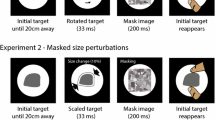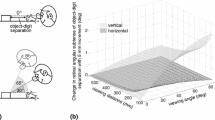Abstract
The aim of the present study was to determine whether normal subjects with one eye covered and patients in whom one eye had been enucleated generate more head movements than subjects using binocular vision during the performance of a visually guided grasping movement. In experiment 1, 14 right-handed normal subjects were tested binocularly and monocularly in a task in which they were required to reach out and grasp oblong blocks of different sizes at different distances. Although the typical binocular advantage in reaching and grasping was observed, the overall head movement scores did not differ between these testing conditions. In experiment 2, seven right-handed enucleated patients were compared to seven age and sex-matched control subjects (tested under binocular and monocular viewing conditions), on the same task as used in experiment 1. While no differences were found in the kinematics of reaches produced by the enucleated patients and the control subjects, the patients did produce larger and faster resultant head movements, composed mainly of lateral and vertical movements. This suggests that enucleated patients may be generating more head movements in order to better utilize retinal motion cues to aid in manual prehension.
Similar content being viewed by others
References
Allara RD, Linberg JV, Tillman W, Odom JV (1986) Visual function in monocular patients following enucleation. Invest Ophthalmol Vis Sci 27:106
Biguer B, Jeannerod M, Prablanc C (1982) The coordination of eye, head, and arm movements during reaching at a single visual target. Exp Brain Res 46:301–304
Biguer B, Prablanc C, Jeannerod M (1984) The contribution of coordinated eye and head movements in hand pointing accuracy. Exp Brain Res 55:462–469
Collett TS (1978) Peering — a locust behaviour pattern for obtaining motion parallax information. J Exp Biol 76:237–241
Dees JW (1966) Accuracy of absolute visual distance and size estimation in space as a function of stereopsis and motion parallax. J Exp Psychol 72:466–476
Ellard CG, Goodale MA, Timney B (1984) Distance estimation in the Mongolian gerbil: the role of dynamic depth cues. Behav Brain Res 14:29–39
Ellard CG, Goodale MA, Scorfield DM, Lawrence C (1986) Visual cortical lesions abolish the use of motion parallax in the Mongolian gerbil. Exp Brain Res 64:599–602
Ferris SH (1972) Motion parallax and absolute distance. J Exp Psychol 95:258–263
Gonzalez EG, Steinbach MJ, Ono H, Wolf ME (1989) Depth perception in children enucleated at an early age. Clin Vision Sci 4:173–177
Goodale MA, Ellard CG, Booth L (1989) The role of image size and retinal motion in the computation of absolute distance by the Mongolian gerbil (Meriones unguiculatus). Vision Res 30:399–413
Lappin JS (1991) Perceiving environmental structure from optical motion. In: Johnson WW, Kaiser MK (eds) Visually guided control of movement. NASA Conference Publications, Moffett, CA, pp 39–61
Legg CR, Lambert S (1990) Distance estimation in the Hooded rat: experimental evidence for the role of motion cues. Behav Brain Res 41:11–20
Marotta JJ, Perrot TS, Nicolle D, Goodale MA (in press) The development of adaptive head movements following enucleation. Eye 9:3
Oldfield RC (1971) The assessment and analysis of handedness: the Edinburgh inventory. Neuropsychologia 9:97–112
Rogers B, Graham M (1979) Motion parallax as an independent cue for depth perception. Perception 8:125–134
Russell JT (1932) Depth discrimination in the rat. J Genet Psychol 40:136–159
Schwartz TL, Linberg JV, Tillman W, Odom JV (1987) Monocular depth and vernier acuities: a comparison of binocular and uniocular subjects. Invest Ophthalmol Vis Sci 28:304
Servos P, Goodale MA, Jakobson LS (1992) The role of binocular vision in prehension: a kinematic analysis. Vision Res 32:1513–1521
Simpson WA (1993) Optic flow and depth perception. Spat Vis 7:35–75
Steinbach MJ, Ono H, Wolf ME (1991) Motion parallax judgements of both as a function of the direction and type of head movement. Can J Psychol 45:92–98
Wallace GK (1959) Visual scanning in the desert locust Schistocerca gregaria forskal. J Exp Biol 36:512–525
Author information
Authors and Affiliations
Rights and permissions
About this article
Cite this article
Marotta, J.J., Perrot, T.S., Nicolle, D. et al. Adapting to monocular vision: grasping with one eye. Exp Brain Res 104, 107–114 (1995). https://doi.org/10.1007/BF00229860
Received:
Accepted:
Issue Date:
DOI: https://doi.org/10.1007/BF00229860




